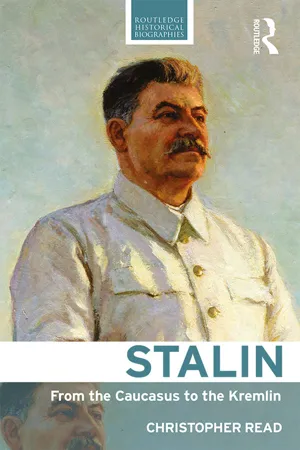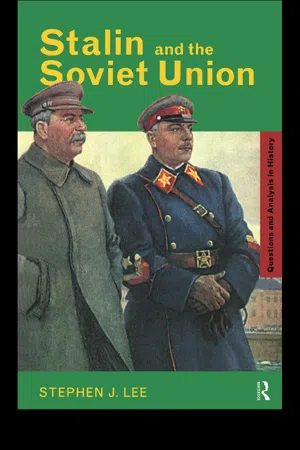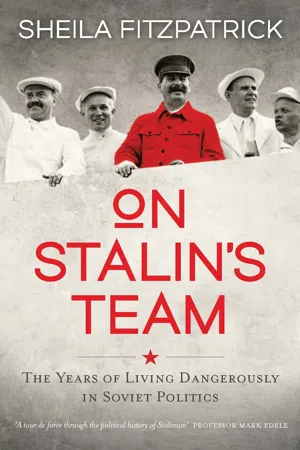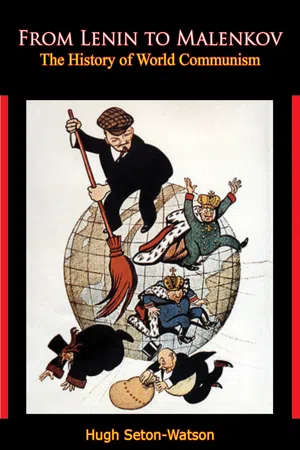Joseph Stalin
Joseph Stalin was a Soviet leader who ruled the USSR with an iron fist from the mid-1920s until his death in 1953. He implemented policies of rapid industrialization and collectivization, but also carried out brutal purges and repression, resulting in millions of deaths. His aggressive foreign policy and role in World War II significantly shaped global politics and international relations during his time in power.
6 Key excerpts on "Joseph Stalin"
- eBook - ePub
- Gregory Claeys(Author)
- 2013(Publication Date)
- CQ Press(Publisher)
...Paul Le Blanc Paul Le Blanc Stalin and Stalinism Stalin and stalinism 768 771 Stalin and Stalinism Joseph Stalin (1879–1953) became the undisputed leader of the Union of Soviet Socialist Republics (USSR) and the world Communist movement in 1929, after a series of power struggles in which he triumphed over his comrades, ruling until his death in 1953. During his reign, what had been the former Russian empire (transformed into the USSR) was industrialized and modernized, and the USSR became a major world power. At the same time, Stalin’s methods in the 1930s were brutally authoritarian and resulted in the deaths of millions of people. Allied with the United States during World War II, and playing a key role in the destruction of the German military machine in that conflict, the USSR quickly became engaged in a global power struggle (the Cold War) with the United States after their joint victory over the Axis powers. As Communist dictatorships were established in eastern Europe and Asia in the late 1940s and early 1950s, modeled on and influenced by Stalin’s regime, many believed (or feared) that what Stalin represented might be the wave of the future. The orientation for the USSR and the world Communist movement that he helped to shape and that he represented has been called “Stalinism.” Born Iosip Djugashvili, son of a Georgian cobbler, and allegedly brutalized by his father, in his youth, he studied at the Tiflis Orthodox Theological Seminary but was expelled in 1899. He was soon active in the Russian Social Democratic Labor Party, a Marxist organization dedicated to advancing the struggles of the working class, advancing a democratic revolution to overthrow the absolute monarchy of tsarism, and eventually bringing about a working-class revolution to replace capitalism with socialism. By 1903, he was drawn to this party’s more militant and centralized faction, the Bolsheviks led by Vladimir Ilyich Lenin...
- eBook - ePub
Stalin
From the Caucasus to the Kremlin
- Christopher Read(Author)
- 2016(Publication Date)
- Routledge(Publisher)
...The main motivation was the United States’ need for strong allies against Japan. The young Stalin can have had no inkling that, at the peak of his career, he would not only be drawn into the great game of international diplomacy but would become one of the most powerful arbiters of international history the world has seen before or since. How did these developments affect Stalin? How did Stalin affect these developments? To some extent, Stalin’s growing involvement in international diplomacy reflects the wider evolution of the party in this area. In the heady days of the October Revolution, the arch-prophet of world revolution, Trotsky, became the first Soviet Commissar for Foreign Affairs, a post he did not expect to hold for long. His task as commissar was, he said, to publish the secret treaties on war aims and then ‘shut up shop’. In other words, given the party’s perspective on world revolution, diplomacy would have no place. If the aim of Bolshevism was to overthrow capitalism then there was no scope to negotiate with capitalist states in a diplomatic fashion. Like many naive Bolshevik battle plans this one barely survived the first encounter with the enemy. Trotsky himself got sucked into playing an almost disastrous diplomatic game with the Central Powers in the first six months of the revolution. The outcome, the Treaty of Brest-Litovsk, was perhaps unavoidable but it was truly a disaster. As the civil war flared up, diplomacy appeared to fade as world revolution took the centre of the agenda. The waning civil war, however, reversed the process. Diplomacy with neighbouring states, many of them breakaways from the Russian Empire, established borders and set up trade agreements. The Russo-Polish War of 1920 ended in a flurry of diplomatic activity. In March 1921, as Soviet Russia turned away from the immediate prospect of world revolution, it even made its first agreement with a major capitalist ‘enemy’, Great Britain, in the form of a trade treaty...
- eBook - ePub
Late Stalinist Russia
Society Between Reconstruction and Reinvention
- Juliane Fürst(Author)
- 2006(Publication Date)
- Routledge(Publisher)
...The period can only be successfully understood when events of international importance are juxtaposed with domestic campaigns. In their thorough analysis of Politburo documents late Stalinism emerges as a series of logical interactions between several players both within and outside the Soviet Union. 15 David Brandenburger widens the picture even further. He argues that the primary influence in the formation of post-war policy and identity remained a Soviet notion of Russian history, which he terms ‘national Bolshevism’. He disputes the centrality of the war, placing the decisive turning point of Soviet history firmly in the pre-war period. 16 In contrast Amir Weiner considers the myth of the Great Fatherland War as essential to the fate of the Soviet/Bolshevik project in the post-war period. He argues for an interpretation of the war as, on the one hand, a watershed, which fundamentally and irrevocably altered the mechanisms of Soviet identity-building, and, on the other, a catalyst of reinforcement, which continued the history of the revolutionary project. He points to the fact that the war by no means signified the end of revolution, but rather its continuation with a new set of norms and rules. 17 His interest in the myth of the war and the social and cultural consequences of its dominance is echoed in Jeffrey Brooks’ work on public culture, which understands the post-war years as a period when people were robbed of their own memory of war. Rather than continuity with the revolutionary mission Brooks sees a continuation of Stalinist performance culture. 18 The extent to which late Stalinism heralded the failure of the Soviet project has been made visible by work done on the social history of the period. Neither entirely devoid of ideology nor entirely devoted to it, late Stalinism was a harbour for contradictory policies and realities...
- eBook - ePub
- Stephen J. Lee(Author)
- 2005(Publication Date)
- Routledge(Publisher)
...This view is not one of absolution, however: his policies did help to engender real plots, lies, and threats to his position. Then this fear-ridden man reacted, and over-reacted, to events. All the while, he could not control the flow of people within the country, job turnover, or illegal acts by managers and many others. He was sitting at the peak of a pyramid of lies and incomplete information, and he must have known it. His power was constrained in fundamental ways, which contributed to his anxiety and tendency to govern by hit-and-run methods. His attitudes and deeds must be situated in the context of vast, popular suspicion generated in part by World War I and the Russian Civil War. Several conclusions follow: Stalin becomes more human than others have portrayed him. And his regime becomes less malevolent but possessed of greater public support than is usually argued. Source B: from Children of the Arbat by A.Rybakov (this had been suppressed in the USSR for twenty years before being published in Britain in 1989). Stalin mused… Yes, the history of mankind was the history of class struggle, but the leader emerged as the expression of class, and therefore the history of mankind was the history of its leaders and its rulers. Idealism did not come into it. The spirit of an epoch was determined by the man who made the epoch himself… …all opponents, past, present and future, had to be liquidated and would be liquidated. The sole socialist country in the world could survive only if it were unshakably stable, and this would also be seen as a sign of its stability by the outside world. The state must be strong in case of war; the state must be mighty if it wants peace. It must be feared. In order to turn a peasant society into an industrialised country, countless material and human sacrifices were necessary. The people must accept this. But it would not be achieved by enthusiasm alone...
- eBook - ePub
On Stalin's Team
The Years of Living Dangerously in Soviet Politics
- Sheila Fitzpatrick(Author)
- 2015(Publication Date)
- Melbourne University Press Digital(Publisher)
...Stalin’s team, in my view, was a quite different animal from anything Nicholas II worked with. 2 For a long time, studies of Stalin focused on the man alone, emphasizing his charisma, cult, and omnipotence, and keen to expose as fallacious claims that institutions like the party Central Committee or the Council of Ministers had any real power. When the archives opened in the 1990s, however, previously invisible aspects of the political process came into sight, and scholars’ interests started to shift to the relationships of Stalin and the men around him, variously referred to as his “entourage” or the “inner circle.” In scholarly terms, the pioneer was the Russian historian Oleg Khlevniuk, starting with his archive-based study of the Politburo of the 1930s, published in the 1990s. In that first pass at the topic, Khlevniuk thought the inner circle/Politburo was important up to the Great Purges but not thereafter. Approvingly quoting Moshe Lewin, he characterized the dependence of the inner circle on Stalin thereafter as “slavish,” concluding that “the Politburo was in fact liquidated as a regularly functioning organ of political leadership, turning into, at best, a consultative instance under Stalin.” This was sharply criticized by Arch Getty, who rejected the “slavish” characterization, pointing out that the inner circle members were powerful politicians in their own right, and that in Stalin’s long absences—without even telephonic communication with the South until 1935—they collectively ran the country, with Stalin intervening by letter and telegram only on a minority of issues. By 2005, after extending his intensive research from the 1930s into the late Stalin period, Khlevniuk himself was seeing things differently and added an oligarchical paradigm to the paradigm of personal dictatorship...
- eBook - ePub
From Lenin to Malenkov
The History of World Communism
- Hugh Seton-Watson(Author)
- 2017(Publication Date)
- Muriwai Books(Publisher)
...Thus Soviet policy in the Ukraine might be compared with the treatment of the lesser nationalities in Poland or Roumania between the wars, and Soviet policy in Central Asia with British policy in Iraq and French policy in Syria. Such comparisons are made extremely difficult by inadequate information from the Soviet side, and in fact they have never been attempted in a systematic manner. Instead there have been comparisons between two propaganda pictures, between a caricature of European imperial rule, with all negative aspects stressed or magnified and all positive achievements ignored, and an idealised version of Soviet rule in which the promised blessings of the future communist utopia are treated as contemporary facts. This fantastic distortion has long passed for the truth in a large part of the world. Members of persecuted national minorities in Eastern Europe, and of frustrated Asiatic or African nations under European rule, longing to believe that somewhere in the world was a state in which these oppressions and inequalities had been abolished, fell ready victims to this propaganda, which had a high priority in Comintern activity both in Eastern Europe and outside Europe. STALIN AND THE OPPOSITION After his stroke of March 1923, Lenin was never well enough to play an active part in Soviet politics. He died in January 1924. During 1923 the disagreements within the Communist Party, which had existed earlier, became really important. The following period marks the rise of Stalin to supreme power. In 1923 and 1924 he combined with Zinoviev and Kamenev against Trotski: between 1925 and 1927 he defeated Zinoviev and Kamenev, who were forced into alliance with Trotski. These fractional struggles, which have both a personal and a doctrinal aspect, had important effects on the world communist movement. Trotski was the most brilliant figure in Russia after Lenin’s death, a fact which brought him more jealousy than devotion from the other leaders of the party...





